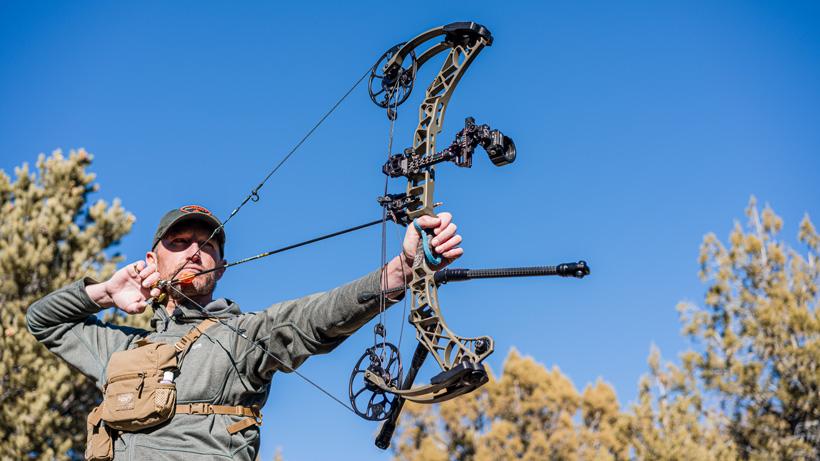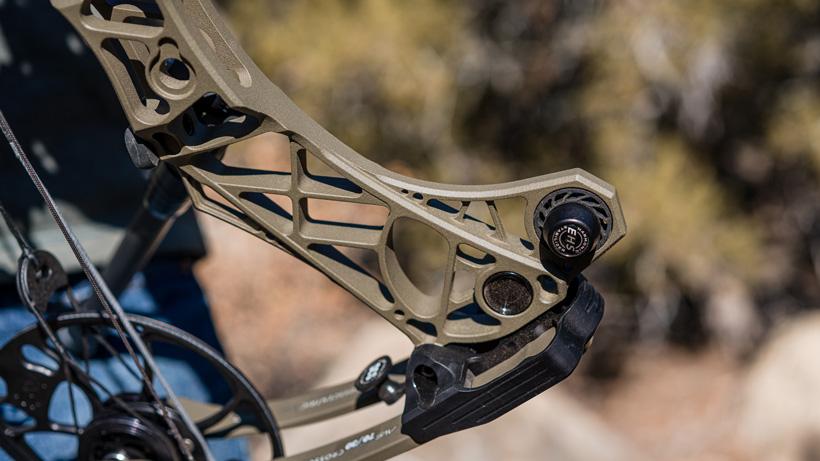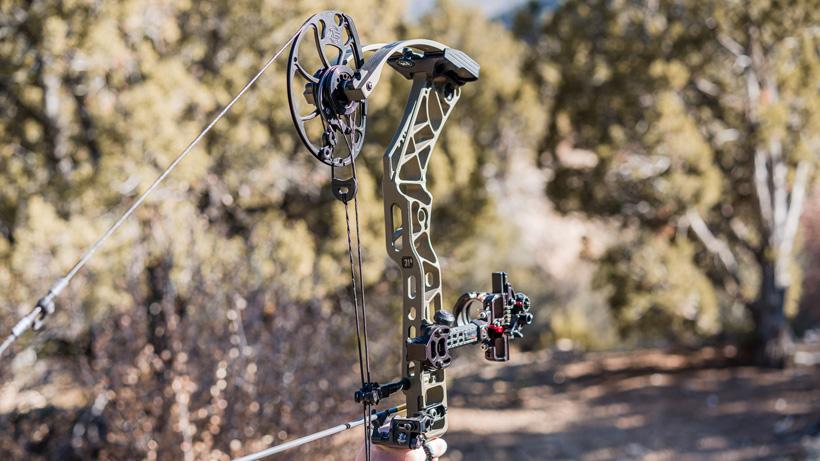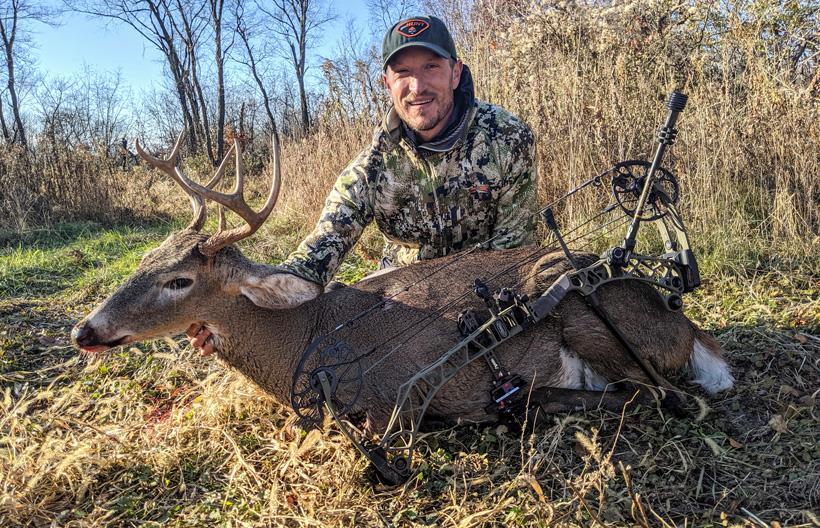








Trail Kreitzer with his Wisconsin whitetail taken with the 2020 Mathews VXR 31.5.

My first modern compound bow was a Mathews Q2 SoloCam that I got in the winter of 2002. I loved that bow and was completely taken by the speed and accuracy I was able to achieve with it so quickly. Over the past 20 years, I have created so many hunting memories with a Mathews bow in my hand. I have owned and hunted with several other name brand bows, but I always seem to return to Mathews Archery. Last week, I toured their manufacturing facility, met some of their knowledgeable staff and learned more about their story. After all of that, it was hard not to fall in love with their bows completely.
While I could talk about the history of Mathews Archery because it’s truly fascinating (and I would encourage everyone to visit the link below to read about the company’s start), for the sake of words, I want to explore some of my personal impressions about the company that makes it so appealing as a bowhunter.
One of the most impressive aspects of Mathews Archery is that they build bows from start to finish within the same two buildings. In those two buildings, the initial engineering is completed, the risers and cams are machined, bows are dipped and finished—all of the parts and pieces are assembled right there on site.The strings are built and installed in the same area where each bow is timed and prepped before it goes out the door. Each person on the assembly line oversees one specific part of the process. Employees control the production and assembly of every single part and piece of a new Mathews bow and it’s all done in-house. Essentially, they control everything and the result is extremely tight tolerances and consistency for each and every bow that goes out the door.
While I was also impressed with the innovation that goes into their bows, I was even more impressed with the innovation in the machinery that they have developed to build and assemble them. Previously, when I have considered buying a new bow, I am really only thinking about the bow itself—which obviously makes sense—but, now, I have a whole new level of appreciation for these bows based upon the technology involved in building and assembling each one.
The older I get the more interested I am in the story of a company and their products. I become more aware of the company's culture and values and I want to try to put my money into quality products that are made by people who I believe are as passionate as I am about archery and hunting. For me, it’s clear that Mathews Archery is first and foremost interested in creating accurate, quiet and innovative bows. Every office I visited was full of deer, elk and antelope mounts. Almost every employee that I talked to was interested in how my hunt was going and eager to share their own hunt stories. Mathews is a company that believes in archery, bowhunting, adventure and storytelling. I really appreciated the culture there and the employees I met walk the walk; they all hunt, they all shoot and are passionate about archery. People can accuse me of being a fanboy and that’s fine, I’ll admit that I am indeed a fan of their bows and the company as a whole.
With that, I also thought I’d add a review of the brand new 2020 Mathews VXR that was just released today. I received a VXR 31.5 about a month ago and, full disclosure, this bow was given to me; however, I have spent the past month shooting it and, in all honesty, I am very impressed with this bow.
First off, the VXR measures in at 31.5” axle to axle, making it the shortest bow I have ever owned. I wouldn’t say that I was excited when I was told that it would be 31.5” bow since I have always preferred a longer ATA based on the premise that they tend to hold better and the string angle at my 30” draw was always too steep for my liking on a short bow.
Interestingly enough, though, the VXR riser is actually longer than the riser of the 35” Halon X that I have been shooting for years. The VRX riser is not only longer, but it’s also lighter and stiffer due to the geometry and bridged design. A longer riser yields a steadier hold. If you think about what it’s like to hold a broomstick in your bow hand and then you tip that from side to side, there’s less movement at the ends because it’s so long. The length of that broomstick adds stability. In comparison, a foot-long ruler in your hand moves a lot when you tip it back and forth. That’s why the riser length matters and the VXR holds extremely steady due to the longer and stiffer riser.
Along those same lines, the geometry of the VXR with its Crosscentric Cams yields a string angle that is still really comfortable even with my longer draw length. I have no issues easily finding my three anchor points on my face: nose to string, string to corner of my mouth and the first knuckle under my jaw. It’s a very comfortable bow at full draw.
Most people ask about draw cycle of a bow and while that’s less of a concern for me than how the bow holds at full draw, it’s worth noting that the VXR draws very smoothly. I wouldn’t suggest that it draws as smooth at the Traverse, but it’s certainly smoother than my Halon X. On the draw, it's very similar to last year's Vertix, which builds fairly evenly throughout the cycle. The rollover into full draw is smooth with no noticeable dive or drop into the back wall. The back wall is firm due to two cable stops (one on each cam) that engage the inner cable. The back wall is firm and the bow holds really well at full draw.
For me, a great addition this year was the option to choose between an 80% or 85% let-off mods. I chose the 80% left off mods and the slight addition in holding weight is welcomed. I get enough holding weight to give me more stability in the back wall, but it doesn’t feel like it wants to jump out of my hand if I relax a little. The VXR also has the Switchweight mod technology. Rather than using your limb bolts to change the draw weight, you can simply maximize the limbs out (which is most efficient) and change the mods to adjust your draw weight in 5 lb increments. I’m very intrigued with 65 lb mods as I have really liked that weight for hunting out of blinds or treestands when drawing a bow from a sitting position or when it’s cold.
The most noteworthy aspect of the VXR is that it is by far the most quiet dead-in-your-hand bow I have ever shot. It’s so quiet that the first few times I shot it, I was really wondering if something was wrong with it. Sounds silly, but it’s disturbingly quiet. For a hunter, obviously that’s a good thing. Less noise equates to a higher likelihood that a buck or bull won’t jump the string. It’s also really dead in the hand. I’ve never cared about some feedback from a bow, but for folks that love a really smooth shock-free bow, the VXR really shines and it is DEAD quiet. I’ll say it one more time: every year, every new bow is the quietest dead-in-the-hand bow—the difference is that the VXR really is.
A few other things to note: the new OD green color of the VXR is really nice and they have a new finish that has a great texture to it. The Engage Grip is thin, comfortable in the hand and easily provides a repeatable grip. I like the grip, but I also love the fact that I can simply remove it and shoot it off the riser. Older Mathews models had sharper edges and, if you wanted to shoot it off the riser, it wasn’t comfortable. The VXR has rounded edges and it feels fantastic in the hand. It’s my preferred method, but I love the fact that they have given me the option.
The VXR tuned extremely easily. I had perfect bullet holes through paper in three arrows and the fixed blade broadhead flight out to 80 yards was very good. It incorporates the top hat shim technology, so if you need to fine-tune your left and rights, it’s easily achieved by moving the cams slightly one way or another. Learn how to easily adjust top hats here. The bow carries really well due to some minor machining in the riser. Carrying it in your hand is comfortable and the same rounding in the riser fits your thumb perfectly at full draw. The VXR also balances really well. In your hand without anything on it, it sits almost straight up and down. I ended up setting mine up with a 12” Bee Stinger MicroHex stabilizer with 3 oz of weight on a 10-degree quick disconnect and a 10” Bee Stinger MicroHex back bar with 7 oz of weight on the Mathews Adjustable V-Bar bracket. For a great article on bow balance with stabilizers, you can check out Brady Miller’s article on Mathews' website here.
My first three days at the range with the VXR, I robin-hooded three different arrows at 20, 30 and 50 yards. I shot some of the tightest groups at 40 yards I have shot in a long time and I was having a blast. The VXR is easy to shoot; some bows I have had to work to shoot well and this is not one of those. It holds so well; the back wall is perfect and it goes off without a hitch.
Trail Kreitzer with his Wisconsin whitetail taken with the 2020 Mathews VXR 31.5.
I was able to take it to Wisconsin to hunt this past week and, even with temperatures in the 20s, it was easy to draw, held true and I took my first whitetail buck at 10 yards. If you are looking for a new hunting bow in 2020, I’d strongly suggest you visit an authorized Mathews dealer and shoot the VXR. From a guy who has been a skeptic of shorter ATA “hunting” bows, it’s shifted my paradigm and I can’t wait to see what I can do with it in 2020.
| Axle-to-Axle |
|---|---|
VXR 28 Specs | 28" |
VXR 31.5 Specs | 31.5" |
| Brace Height |
VXR 28 Specs | 6" |
VXR 31.5 Specs | 6" |
| Draw Weight |
VXR 28 Specs | 60, 65, 70, 75 lbs. |
VXR 31.5 Specs | 60, 65, 70, 75 lbs. |
| Draw Length |
VXR 28 Specs | 25.5"-30" |
VXR 31.5 Specs | 27"-31" |
| Let-Off |
VXR 28 Specs | 80 or 85% |
VXR 31.5 Specs | 80 or 85% |
| Physical Weight |
VXR 28 Specs | 4.44 lbs |
VXR 31.5 Specs | 4.66 lbs |
| IBO Rating |
VXR 28 Specs | Up to 344 FPS |
VXR 31.5 Specs | Up to 343 FPS |
| Cam |
VXR 28 Specs | Crosscentric w/Switchweight Technology |
VXR 31.5 Specs | Crosscentric w/Switchweight Technology |
| MSRP |
VXR 28 Specs | $1,099 |
VXR 31.5 Specs | $1,199 |
| VXR 28 Specs | VXR 31.5 Specs |
|---|---|---|
Axle-to-Axle | 28" | 31.5" |
Brace Height | 6" | 6" |
Draw Weight | 60, 65, 70, 75 lbs. | 60, 65, 70, 75 lbs. |
Draw Length | 25.5"-30" | 27"-31" |
Let-Off | 80 or 85% | 80 or 85% |
Physical Weight | 4.44 lbs | 4.66 lbs |
IBO Rating | Up to 344 FPS | Up to 343 FPS |
Cam | Crosscentric w/Switchweight Technology | Crosscentric w/Switchweight Technology |
MSRP | $1,099 | $1,199 |